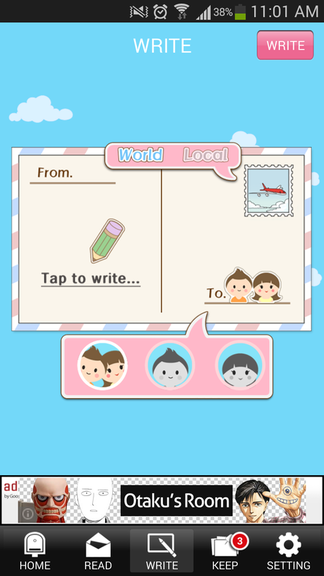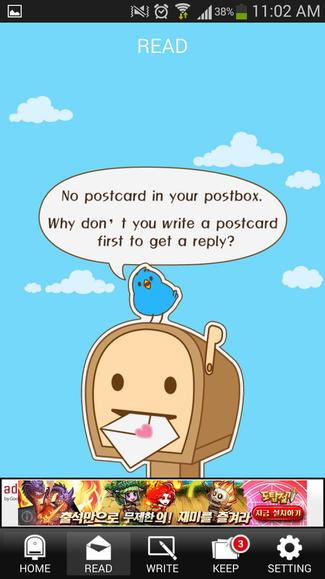My favorite subtype of student at the Korean language program at which I study is definitely the Singaporean. (I might also say the Japanese, but I know only one so it fails to qualify as a subtype.) I perceive the Singaporeans to possess optimism, humorousness, and openness, even though they study hard they seem basically relaxed, unlike some of the Chinese. It also helps that we can communicate freely, as their English is as native level as my own.
A few days ago, two of the Singaporeans (H.P.G. [Level 4] and T.S.S. [Level 3]) were crowded ’round a phone in the hallway in-between classes. I peered over a shoulder. It was “DokiDoki Postbox” out of Japan; a phone app.
What is Doki Doki Postbox? I didn’t know but soon learned and got on board.
The premise is simple. You write a “postcard” — a short, text-only message — which, once sent, is delivered to a totally unknown recipient
(randomized by computer algorithm within the program’s database of anonymous accounts). You have no way to identify each other once (if) contact is established, except by nationality (displayed as a flag) and gender. Once contact is established, you can continue the exchange of “postcards” with the same person until he or she stops responding. You may send only one postcard at a time and must wait for a reply. If the other person breaks contact by not responding to your postcard, you lose all possibility of contacting that person ever again. There is an exciting edge to this. It is like an Internet Age equivalent of “a message in a bottle set adrift at sea”, but semi-instantaneous. It also re-creates some of the feel of the very early Internet of the 1990s, when conversations were limited to basic text. I remember many hours peering over my cousin B.W.’s shoulder in Connecticut in the mid-1990s, amazed that he was talking (via modem) late into the night with people around the country. It was a kind of magic to me.
Here is what this program looks like (screenshots from my phone). As mentioned, you can choose only two parameters for your postcard recipient: (1) “World” (outside my country) or “Local” (my country); (2) “Any Gender / Male / Female”.
Here is what this program looks like (screenshots from my phone). As mentioned, you can choose only two parameters for your postcard recipient: (1) “World” (outside my country) or “Local” (my country); (2) “Any Gender / Male / Female”.
Here is a series of “postcards” exchanged between me (the initiator) and a Korean male unknown to me.
|
Original Korean Conversation
Me: 오. 하이. 요즘 잘 지내고 있죠? Korean: 아 니 요 Me: 왜 그래요. 설명해 주세요. Korean: 잘지낼 여유가 없음. Me: 잘 지내고 할 수 있는 방법이 필요하죠. 내 생각으로…치킨, 삼겹살, 등. Korean: ㅋㅋㅋㅋㅋ 운동할래요 걍. |
Translation into English
Me: Oh, hi. You’ve been well lately, I hope? Korean: N-o-p-e Me: What do you mean? Please explain this. Korean: I’ve been too busy to relax. Me: We all need ways to enjoy life, don’t we. My opinion…fried chicken, grilled pork, etc. Korean: Hahaha. I’ll just play some sports. |
The space of time between each of these “postcards” was a few hours.
H
e didn’t seem to realize that I wasn’t a Korean native speaker. Other exchanges I’ve played around with resulted in Koreans promptly saying things I could not decipher so I stopped responding to them. Koreans are big into slang. One of my “world” postcards ended up being delivered to an American female. My country flag displays as South Korea, so I decided to have some fun. I wrote: “Can you tell me a good USA food?” Her answer: “McDonald’s”.


